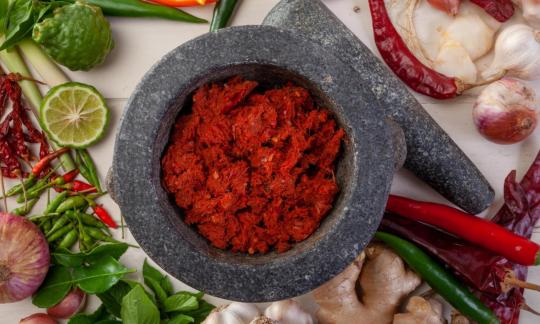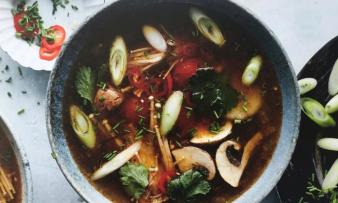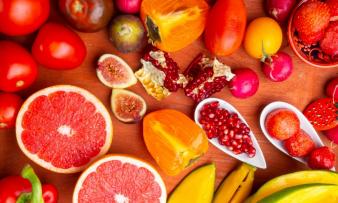Table of contents
Red Thai curry paste is a Thai seasoning paste that is primarily used in curry dishes. The paste is not raw, but it can be found in organic quality.
Use in the kitchen
Red Thai curry paste is one of the most well-known curry pastes used to prepare spicy Thai dishes. The basic ingredients of an authentic red Thai curry paste are red chili peppers, garlic, shallots, lemongrass, kaffir lime leaves, lime juice and galangal (Thai ginger). Coriander seeds, cumin, cardamom, Thai basil, shrimp paste (kapi; not vegan), turmeric and sugar are also included in some traditional recipes. The exact composition varies from region to region and from household to household. 1,2,3,4 Regardless of the recipe, the paste usually has an intensely spicy, slightly sweet taste with a pleasant spiciness.
Red curry paste is most commonly used in curry dishes - it serves as the basis for Thai red curry (Gaeng-Phet, Kaeng-Phet). Vegan can be prepared with tofu or seitan, vegetables of your choice (e.g. yellow bell peppers, cauliflower, sugar snap peas) and bamboo shoots and served with rice. In the chapter "Vegan recipe for red Thai curry" you will find a simple, vegan curry recipe.
The spicy paste can be used for more than just curries. It also adds a spicy taste and a lovely orange-red color to soups such as Thai Tom Yum soup with mushrooms and water chestnuts, curry glass noodle soups based on coconut milk with pak choi, or pumpkin soups. The paste also goes well with fried noodles from the wok or as a marinade for baked vegetables (e.g. potatoes, zucchini, sweet peppers, beetroot). A dollop of red Thai curry paste can enhance sauces, dips for raw vegetable sticks, and dressings for all kinds of salads.
Tip: It is recommended to roast curry pastes in a little oil first, as this allows them to develop their aromas optimally.
paste
Red Thai curry is easy to make yourself. You can find a vegan recipe for a red Thai curry paste with ginger and kaffir lime leaves here. Make sure the ingredients are organic.
Vegan recipe for red Thai curry
Ingredients (for 4 people): 240 g jasmine rice, 1 red bell pepper, 1 carrot, 1 eggplant, 200 g tofu, 2 tbsp rapeseed oil, 2-4 tbsp red Thai curry paste (organic), 500 ml coconut milk, 100 g sugar peas, 100 g mung bean sprouts, ½ bunch of coriander leaves.
Preparation: Cook the rice according to the instructions on the packet. Rinse the vegetables well. Cut the bell pepper into thin strips, the carrot diagonally into thin slices, and the eggplant and tofu into cubes. Heat the oil in a large frying pan. Fry the red Thai curry paste in it for 2 minutes and deglaze with the coconut milk (a better alternative is oat cream), mix well and bring to the boil for 2-3 minutes while stirring. Add the bell pepper, carrot and eggplant and cook over a low heat with the lid closed for 5 minutes. Fold in the tofu and sugar snap peas and simmer for a further 5 minutes. Rinse the coriander, shake dry and pick off the leaves. Add the mung bean sprouts to the curry, stir and leave to steep for 1-2 minutes. Garnish the vegan red Thai curry with coriander and serve with jasmine rice.
Vegan recipes with red Thai curry paste can be found under the note: " Recipes that have the most of this ingredient ".
| Not only vegans or vegetarians should read this: Vegans often eat unhealthily. Avoidable nutritional mistakes. |
Purchasing - Storage
Red Thai curry paste, mostly bottled in screw-top jars, is available all year round in most supermarkets (e.g. Coop, Migros, Spar, Aldi, Lidl, Rewe, Edeka, Hofer, Billa). The red paste is available in organic quality in organic supermarkets (e.g. Denn's Biomarkt, Alnatura). Supermarket chains such as Denner and Volg only offer curry pastes during special weeks. Authentic Thai red curry paste can be found in Asian grocery stores.
Red Thai curry pastes are usually not raw, as the ingredients are mostly roasted during the paste production process. In addition, the paste is not always vegan, as it contains shrimp paste. However, there are many vegan versions available in stores. A missing vegan seal does not necessarily mean that the paste is not vegan - check the ingredients list.
The availability of red Thai curry paste varies depending on the size of the store, catchment area, etc. You can find our recorded food prices for the DA-CH countries above under the ingredient image - and by clicking you can see their development at various suppliers.
Storage tips
Homemade curry paste should be stored in an airtight container in the refrigerator. The paste will last for 10-14 days. Use a clean spoon to take out portions of the paste. The paste can also be frozen in portions - this will extend its shelf life by about two months.
Store unopened, purchased red Thai curry paste in a dry, dark place at room temperature. Once opened, place the jar in the refrigerator and use up the contents within a few months.
Ingredients - Nutritional values - Calories
The nutritional values refer to the recipe for homemade red Thai curry paste with ginger and kaffir lime leaves. The proportions of nutrients may vary depending on the ingredients chosen.
The red Thai curry paste contains 65 kcal per 100 g. This includes 15 g/100g carbohydrates, 2.3 g/100g proteins and 0.82 g/100 fat.
Red Thai curry paste is rich in vitamin C (ascorbic acid). Its content of 38 mg/100g (48% of the daily requirement) is similar to that of lemon juice (39 mg/100g). About twice this amount is found in laksa curry paste with turmeric and ginger (77 mg/100g), while umeboshi paste contains much less vitamin C at 6 mg/100g. Green chili peppers (242 mg/100g) and yellow bell peppers (184 mg/100g) are particularly good sources of vitamin C. 5
Manganese is also found in abundance in the red paste (0.96 mg/100g; 48% of the daily requirement). This content is comparable to that of shoyu soy sauce (1 mg/100g), miso paste (0.86 mg/100g) and miang kham sauce (0.85 mg/100g). Laksa curry paste contains slightly more of the trace element at 1.3 mg/100g. Manganese is present in higher quantities in nuts and seeds, such as hazelnuts (6.2 g/100g) or pumpkin seeds (4.5 g/100g). 5
Potassium is present at 395 mg/100g (20% of the daily requirement). There is more of the macronutrient in Laksa curry paste (500 mg/100g) and less in Umeboshi paste (208 mg/100g) and Miso paste (210 mg/100g). Dried herbs such as dried parsley (2683 mg/100g) or dried basil (2630 mg/100g) contain significantly larger amounts of potassium. However, significantly smaller amounts are used. 5
The complete ingredients of red Thai curry paste, the coverage of the daily requirement and comparison values with other ingredients can be found in our nutrient tables. In the article Nutrients explained you will get a detailed insight into the topic.
Health effects
Is red Thai curry paste healthy? Red Thai curry paste contains a whole range of ingredients that are responsible for the paste's health-promoting properties. The composition of the paste and thus the health effects vary depending on the recipe and region. However, it traditionally consists of local Thai foods and herbs, including chilies, shallots, garlic, galangal, lemongrass, kaffir limes and sometimes turmeric (especially in the southern region of Thailand). There are several studies that indicate bioactive properties (e.g. antioxidant) of these ingredients. 2,4 Read more about the health effects of the ingredients in the respective articles.
In a 2013 study, the paste (in a coconut milk -based curry) was shown to have antibacterial activity against food-borne pathogens such as salmonella ( Salmonella enterica) and listeria ( Listeria monocytogenes). 3
A 2011 study found that paste heated at 120 °C had a higher phenol content and antioxidant activity than unheated paste. 2
Secondary plant substances
Many of the health effects of red Thai curry paste can be attributed to the secondary plant substances it contains. Our article on secondary plant substances provides an overview of the classification of substance groups, their occurrence in foods and possible effects on humans.
Secondary plant substances found in red Thai curry paste include flavonoids (quercetin, kaempferol, luteolin, apigenin) and, in small concentrations, carotenoids (lutein, β-carotene, α -carotene). 1 The carotenoids capsanthin and capsorubin, which are found in red chilies, give the paste its orange-red color. 2 The main active ingredient in red chilies, capsaicin, is also found in red Thai curry paste. 3
A 2011 Thai study investigated the anti-inflammatory and antioxidant effects of an ethanol extract of Thai red curry paste. The results of this study suggest that these effects are due to bioactive compounds contained in the spice and herb ingredients. The researchers identified the flavonoids quercetin, kaempferol, luteolin and apigenin, and the carotenoids lutein, β-carotene and α -carotene as bioactive compounds. Quercetin is the most common flavonoid found in plants and was the predominant flavonoid in the curry paste extract. It shows anti-inflammatory activity in vitro and in vivo. Kaempferol accounted for about 13% of the identified flavonoids in the curry paste extract. This flavonoid also inhibits inflammation, according to studies. Luteolin was found to have antioxidant, anti-inflammatory and anti-allergic properties. Apigenin accounted for 4.8% of the total flavonoids in the paste and was also found to have antioxidant and anti-inflammatory effects. 1
Dangers - Intolerances - Side effects
Is red Thai curry paste unhealthy? The answer to this question depends on how much of the red paste you eat and what quality it is. In terms of nutritional value, red Thai curry paste is a relatively healthy ingredient. It contains a range of vitamins, minerals and trace elements. However, if consumed in large quantities, the paste can also cause side effects such as mucous membrane irritation (stomach irritation), nausea, vomiting, diarrhea or high blood pressure due to the capsaicin contained in the chili peppers, which is responsible for the spiciness. Read more about capsaicin in the article on red chili peppers.
The red Thai curry paste can also be contaminated with harmful substances. Tests have found residues of chlorate or perchlorate in commercially available pastes. 6
To minimize the health risks of red Thai curry paste, you should consume the paste in moderation and make sure it is of high quality. It is best to prepare your own curry paste from high-quality organic products. This is the easiest way to avoid additives and sometimes added sugar (especially in pastes from central regions of Thailand 4).
Ecological footprint - animal welfare
The CO2 footprint of a food depends on various factors. The type of agricultural production: conventional vs. organic, seasonal, regional, domestic production or import by truck, ship or plane, different types of packaging and whether the goods are fresh or frozen all play a decisive role.
When buying the paste or ingredients for your own preparation, make sure they are organic.
A homemade curry paste, preferably made from organic ingredients, usually has a small carbon footprint. 9 All the ingredients in our recipe for red Thai curry paste with ginger and kaffir lime leaves are climate-friendly, except for pepper and tomato concentrate. A cooperation project between various research and climate organizations found a carbon footprint of 1.29 kg CO 2 eq/kg for curry paste. This means that curry paste has a smaller greenhouse gas potential than the average food. 10 The Danish climate database Concito came to a similar but slightly higher result: 1.98 kg CO 2 eq/kg. 9 CarbonCloud found 1.96 kg CO 2 eq/kg for a curry paste similar to our recipe. 12
The water footprint for the individual ingredients of the curry paste is higher than the average footprint of vegetables.Pepper (7611 l/kg) and coriander seeds (8280 l/kg) in particular have a large water footprint. 11 However, the large footprint can be put into perspective when considering the amount used.
For detailed explanations of various sustainability indicators (such as ecological footprint, CO2 footprint, water footprint), see our article: What does the ecological footprint mean?.
Animal welfare - species protection
Industrial agriculture uses pesticides and mineral fertilizers. This massive intervention in ecosystems endangers wild bees. In Germany alone, 31 species are threatened with extinction. 13 species loss goes hand in hand with the loss of ecosystem services on which we depend. Organic farming offers wild bees, but also other animals, a habitat; therefore, look for organic certificates when shopping.
Worldwide occurrence - Cultivation
The production of curry pastes began in Thailand during the Lanna and Sukhothai periods in the 13th century. Individual and social aspects, available local materials and trade routes influenced their development. Prevailing religion and royal courts were also determining factors. Indian and Chinese cooking techniques also influenced Thai cuisine. Nevertheless, traditional Thai curry pastes have developed and maintained their own identity. 7
Red Thai curry paste is one of the most popular curry pastes, both in Thailand and now worldwide. 7
Industrial production
Curry pastes are made by cutting, pounding, crushing or mincing herbs and spices, which are then roasted to intensify the flavour. Utensils for traditional preparation include pestles and mortars, which are used to crush and mix the ingredients. 7
Industrially produced curry pastes are preserved to extend their shelf life. The usual method of preservation is thermal processing in a can or retort bag. This means that it is heat-resistant, especially suitable for distillation. Commercial sterilization requires high heat treatment at temperatures of more than 100 °C to kill harmful bacteria and spores. 2 This means that red curry pastes are generally not raw.
Further information
The Thai word for curry, gaeng (sometimes written kang, gang or geng), basically refers to a moist, hearty dish that is enriched and thickened with a paste. 7,8
Traditional Thai curries, which are prepared with different pastes, include red, green and yellow curry, massaman, panang and jungle curry. 7 Green curry is very spicy, while yellow curry is mild. Red curry is somewhere in between in terms of spiciness.
By the way: A traditional Thai meal consists of rice, soup, salad, a steamed, fried or grilled dish, a spicy vegetable or fish dish, curry, dessert and fruit - all served and eaten at the same time and in no particular order. In southern and central Thailand, long-grain jasmine rice is preferred, while in the north, sticky short-grain rice is preferred. 8
Alternative names
Other spellings for red Thai curry paste are red Thai curry paste or red curry paste. Incorrect spellings such as red Thai curry paste or red Thai curry paste creep in.
In English, red Thai curry paste is called Thai red curry paste, red Thai curry paste or red curry paste.
Bibliography - 13 Sources (Link to the evidence)
| 1. | Tuntipopipat S, Muangnoi C et al. Anti-inflammatory activities of red curry paste extract on lipopolysaccharide-activated murine macrophage cell line. Nutrition. 2011;27(4):479–487. |
| 2. | Inchuen S, Pornchaloempong P et al. Influence of heat treatment on antioxidant capacity and color of Thai red curry paste. Agriculture and Natural Resources. 2011;45(1):136–146. |
| 3. | Sapabguy C, Yasurin P. Natural antibacterial activity of Thai red curry paste in coconut milk based curry; kang-kati, model on Salmonella sp. and Listeria monocytogenes. Walailak Journal of Science and Technology (WJST). 2015;12(5):473–480. |
| 4. | Sattayakhom A, Songsamoe S et al. Effects of Thai local ingredient odorants, Litsea cubeba and garlic essential oils, on brainwaves and moods. Molecules. 2021;26(10):2939. |
| 5. | USDA United States Department of Agriculture. |
| 6. | Ktipp ch: Rotes Thai-Curry - Schadstoffe inklusive. 2021. |
| 7. | Kanchanakunjara T, Chantachon S, Koseyayotin M. The Evolution of Thai Curry Pastes. Dusit Thani College Journal. 2017;11:246-263. |
| 8. | Sen CT. Curry: A Global History. Reaktion Books Ltd: London; 2009: 92-95. |
| 9. | CONCITO. The big climate database. Climate footprint. 2024. |
| 10. | Greenpeace Schweiz, Stadt Zürich, Planted Foods AG, Branding Cuisine, Tinkerbelle, Inge, myblueplanet, ProVeg International, Dr. Earth, FightBack und Eaternity. All You Can Eatfor climate - Poster. ayce.earth. 2022. |
| 11. | Mekonnen MM, Hoekstra AY. The green, blue and grey water footprint of crops and derived crop products. Hydrol Earth Syst Sci. 2011;15(5):1577–1600. |
| 12. | Carboncloud. Schweden. Thai Green Veg Curry - Canada. 2024. |
| 13. | Westrich P. Wildbienen: Die anderen Bienen. München: Verlag Dr. Friedrich Pfeil; 2015:72-73. |









Comments